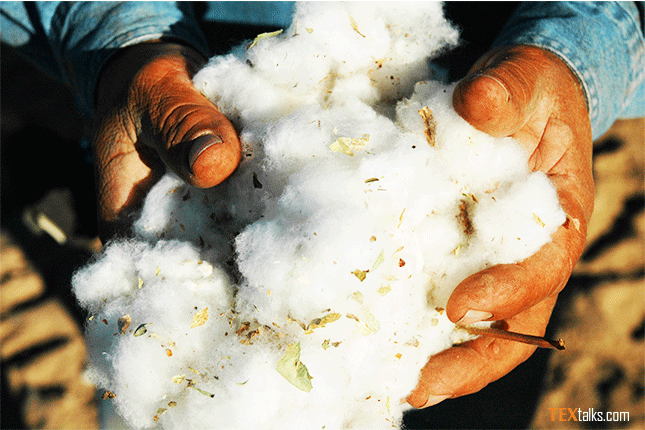The fourth largest producer of cotton in the world, more importantly Pakistan has the third largest spinning capacity after China and India in Asia with thousands of ginning and spinning units producing textile products from cotton. Approximately 1.5 million smallholder farmers rely on cotton for a living having to contend with the effects of extreme weather and pest outbreaks damaging the crops, the future of Pakistan’s cotton production depends on how efficiently the farmers will react to climate change and promoting sustainable farming practices. With a 60% lower cotton yield the last year was the worst in a decade, the little that was harvested was of poor quality as the crop was attacked by the white fly.
Pakistani cotton contains the first generation of Bt gene (genetically manipulated seeds) since 2002. Although formally unapproved and unregulated, The cultivation of these varieties increased rapidly after 2005. In 2007, nearly 60 % of the cotton area was under BT varieties. In Sindh province, local Sindh varieties of cotton are also grown in about 40% of the area. A research conducted in 2010 showed that the cotton yield has been enhanced insignificantly as compared to non-Bt varieties and the use of pesticides went down about 20%. A relatively better performance of Bt seeds as is not very convincing.
Thus, new cotton breeding techniques and improved production methods have brought about a certain betterment in the overall scenario of cotton. Despite the historical rise in its production, the yield of cotton is reading a plateau due to several reasons. Due to insect susceptible nature of all cotton seed varieties, insect pests are the main suppressors of cotton productivity all over the world, mainly managed by the use of insecticides. Unavailability of good quality seed, cotton diseases, drought and heat stresses, laborious picking and unpredicted cotton pricing and shifting of cropping patterns in the cotton zone are among other major constraints. In addition, the acreage under cotton is shrinking with farmers switching to less disease-prone crops like sugar cane.
2019/20 cotton production is forecast at 8.0 million 480 lb bales, up 500,000 bales from the revised 2018/19 estimate. This projected production Yield is expected to be higher than last year due to recent government incentives toenhance cotton production in the country. based on sufficient water and certified seed availability.
Improved. cotton seed quality for the overview of the respective government departments which are distributing high quality cotton seed to farmers has to be extended. The provision of certified cotton seeds is still too low (46,6% in 2015). The current cotton sowing season in Punjab started on 1 April despite the fact that agricultural experts advised the growers to start cultivation of cotton crops after mid-April as cotton sowing before this period is subject to being attacked by pests severely.
The fight against pest and vermin with insecticides has to be made more efficient and environmentally friendly. Pesticides in food items and their accumulation in tissues has direct toxic effects on humans and other non-target organisms. There are also serious ecological and environmental problems with over-reliance on pesticides. Moreover, agricultural workers suffer from pesticide poisoning each year – this includes a significant number of women, the main workforce in the cotton fields.
One possible solution would be to switch from genetically manipulated cotton varieties (GMO) like Bt cotton to organic cotton that is less susceptible to pests, improves yields and is prone to fetch a better market price and acceptance internationally. An encouraging development has come from Balochistan’s tribal areas, where small farmers had been growing organic cotton on land that was cleaned of chemical fertilisers and pesticides and finally got certification last year. Cotton was successfully grown without the use of chemical fertiliser or pesticide and the seeds were not genetically modified.
The objectives of GOP’s Textile Industry Division are to formulate strategies and programs to enable the textile sector to meet these challenges and attain global competitiveness”
The development of a new policy to promote and support the cultivation of organic cotton seeds is necessary. While the Central Cotton Committee of the Ministry of National Food Security and Research is mainly responsible, its webpage not been updated since 2017 shows the state of affairs. On the other hand, the Centre for Agriculture and Bioscience International (CABI) under its Cotton Advocacy for Policy and Seed (CAPAS) Project is supporting the procurement, production and certification of non-GMO cotton seed as well as the development of organic cotton policy in Pakistan. A project states that will be implemented in close collaboration with the Government departments (federal & provincial), input suppliers (private sector), seed enterprises (both public and private) and farmer associations, will initiate technical and policy interventions for the local availability of organic cotton seed and other non-chemical inputs. to promoting healthy cotton production and improving the quality of Pakistan’s cotton. It would also counter another tendency in Pakistan, the switching of farmers from cotton to sugar cane because of the fact that sugar cane is less susceptible to heat and profits due to the political influence sugar barons are practicing. If this trend is not stopped immediately Pakistan’s textile industry will suffer and depend on imported cotton even more than that is already the case.
This sector employs about 45% of the total labour force in the country and 38% of the manufacturing workers. At present, there are 1,221 ginning units, 442 spinning units, 124 large spinning units and 425 small units which produce textile.
This single largest export-oriented sector of Pakistan textile has spiked to full-capacity production after the government withdrew duties and taxes on import of the raw cotton in January. Besides, Islamabad is getting higher export orders for textiles since China, the single largest textile exporter at world across, is lying closed to fight against the deadly coronavirus for the past couple of months. These developments in textile industry may decisively support the government to achieve the set export target of $24-25 billion this fiscal year (July-2019 to June 2020).



